[1]
T. Chapman, Genetic heavy metal toxicity, Iuniverse, Lincoln, (2008).
Google Scholar
[2]
K. Straif, L. Benbrahim-Tallaa, R. Baan, Y. Grosse, B. Secretan, F. El Ghissassi, V., N. Guha, C. Freeman, L. Galichet, V. Cogliano; WHO International Agency for Research on Cancer Monograph Working Group, A review of human carcinogens-part C: metals, arsenic, dusts, and fibres, Lancet Oncol. 10 (2009).
DOI: 10.1016/s1470-2045(09)70134-2
Google Scholar
[3]
Y. Chervona, A. Arita, M. Costa, Carcinogenic Metals and the Epigenome: Understanding the effect of Nickel, Arsenic, and Chromium, Metallomics. 4 (2012) 619-627.
DOI: 10.1039/c2mt20033c
Google Scholar
[4]
R.B. Hayes, The carcinogenicity of metals in humans, Cancer Causes Control. 8 (1997) 371-385.
Google Scholar
[5]
IARC. Agents Classified by the IARC Monographs, Volumes 1-108, http: /monographs. iarc. fr/ENG/Classification/index. php. Lyon: International Agency for Research on Cancer (IARC), World Health Organization, (2013).
DOI: 10.1002/food.19890331018
Google Scholar
[6]
B. Sripa, P.J. Brindley, J. Mulvenna, T. Laha, M.J. Smout, E. Mairiang, J.M. Bethony, A. Loukas, The tumorigenic liver fluke Opisthorchis viverrini-multiple pathways to cancer, Trends Parasitol. 28 (2012) 395-407.
DOI: 10.1016/j.pt.2012.07.006
Google Scholar
[7]
B. Sures, G. Jьrges, H. Taraschewski, Relative concentrations of heavy metals in the parasites Ascaris suum (Nematoda) and Fasciola hepatica (Digenea) and their respective porcine and bovine definitive hosts, Int. J. Parasitol. 28 (1998).
DOI: 10.1016/s0020-7519(98)00105-2
Google Scholar
[8]
G.E. Kirichuk, A.P. Stadnichenko, I.A. Pershko, The effect of the trematode invasion and accumulation of heavy metals onto the pond snail (Mollusca: Gastropoda: Lymnaeidae), Parazitologiia. 36 (2002) 295-303.
Google Scholar
[9]
W.M. Lotfy, A.M. Ezz, A.A.M. Hass, Bioaccumulation of Some Heavy Metals inthe Liver Flukes Fasciola hepatica and F. gigantica, Iran. J. Parasitol. 8 (2013) 552-558.
Google Scholar
[10]
N.J. Morley, J.W. Lewis, D. Hoole, Pollutant-induced effects on immunological and physiological interactions in aquatic host–trematode systems: implications for parasite transmission, J. Helminthol. 80 (2006) 137-149.
DOI: 10.1079/joh2006345
Google Scholar
[11]
M.N. Lvova, S. Tangkawattana, S. Balthaisong, A.V. Katokhin, V.A. Mordvinov, B. Sripa, Comparative histopathology of Opisthorchis felineus and Opisthorchis viverrini in a hamster model: an implication of high pathogenicity of the European liver fluke, Parasitol. Int. 61 (2012).
DOI: 10.1016/j.parint.2011.08.005
Google Scholar


